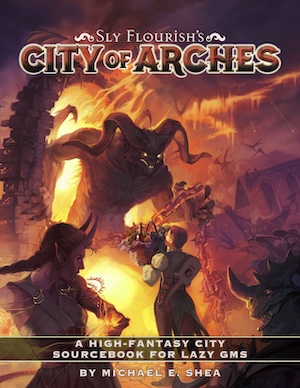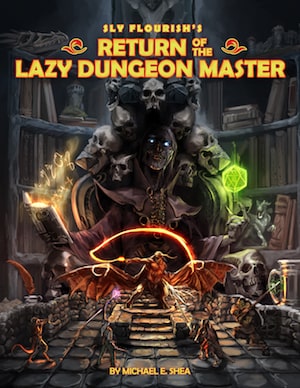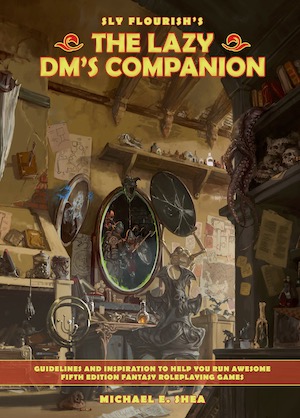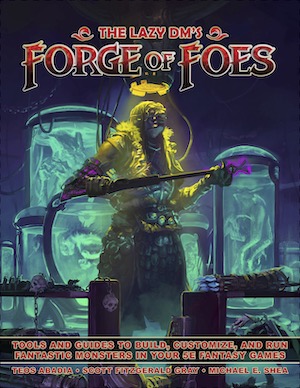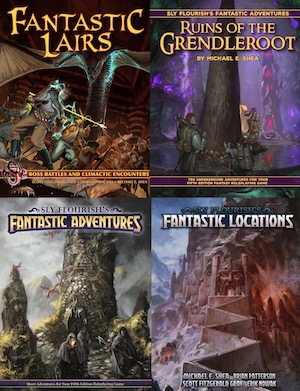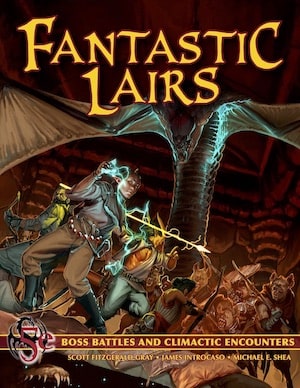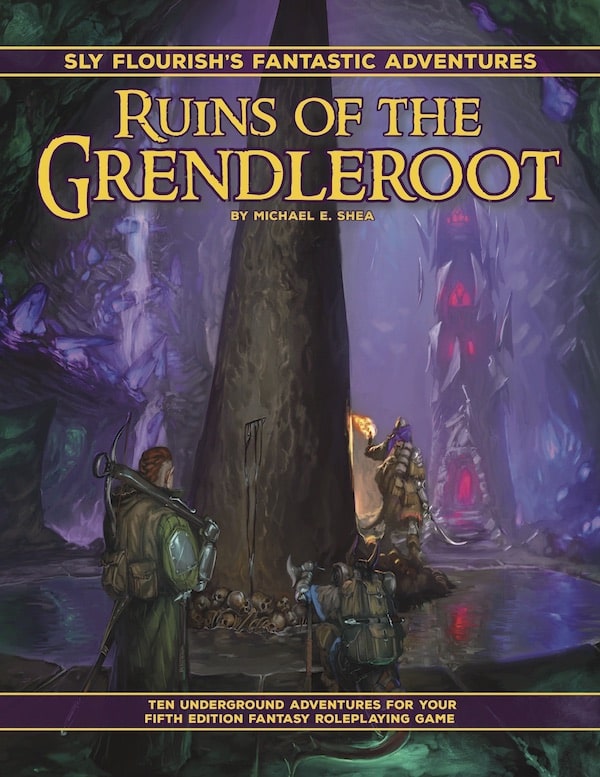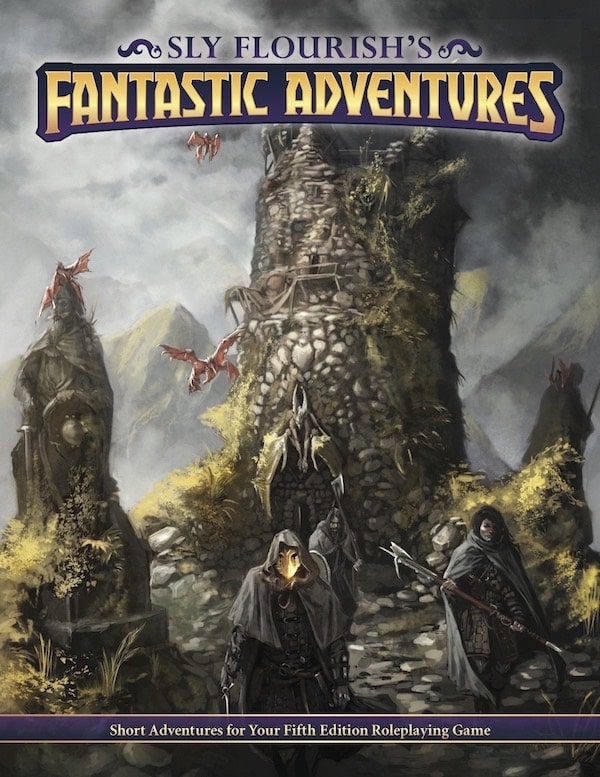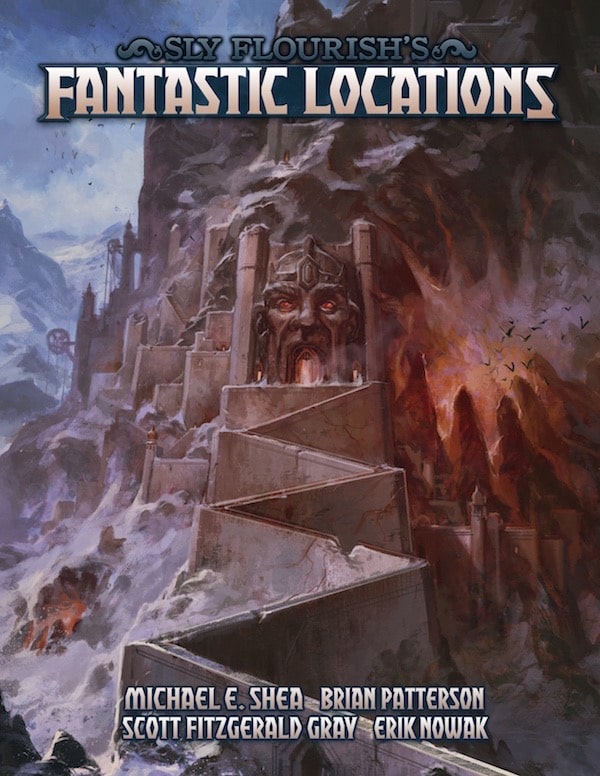New to Sly Flourish? Start Here or subscribe to the newsletter.
Running Towns in Fantasy RPGs
by Mike on 13 November 2023
When the characters reach a town or other large settlement, the pacing of our D&D game changes — and not always in a good direction. Towns are tricky environments to run. They have a wide range of locations, oodles of NPCs, and often too many options for things to do.
"You enter the village of Redtower. What do you want to do?" can be a game-killing introduction.
So how do we ensure when the characters reach a town, it's as interesting as the rest of our game? Let's take a look.
Identify a Fantastic Feature
What makes this town unique or interesting? What noteworthy feature grabs the characters' attention when they enter the town? What famous or infamous landmark lies near the town? Add at least one of these fantastic features and probably no more than three – enough to define the town in the eyes of the characters and your players.
Here are ten examples of notable features:
- The town surrounds a huge sinkhole with a river flowing down into its depths.
- The town surrounds the skull of a huge twisted beast half-buried in the ground.
- The town floats on an earthmote one hundred feet above the edge of a vast canyon. Rope bridges connect smaller floating earthmotes providing a path to the town.
- The town surrounds a single obsidian spire piercing out of the ground.
- The petrified form of an ancient dragon snarls in the town square.
- The town always appears to be in the darkness of night with an alien moon above.
- An ancient portal to an alien world lies dormant, only opening every five hundred years.
- The horns of a sleeping tarrasque pierce out of the ground beneath the town but no one can be bothered to move it.
- The marble statue of a priestess shining a wand into the heavens stands in the center of town, the light of the wand seems to reach a golden star above.
You can find more fantastic features, and generate your own, using the "Random Monuments" table on page 12 of the Lazy DM's Workbook or the "Core Adventure Generators" tables on page 6 of the Lazy DM's Companion.
Set Up a Situations
When the characters enter the town, it works best if they get involved in something right away. Try launching into a situation just as they walk into town. Such situations help define the town and offer interesting choices. Here are ten examples of situations the characters may encounter in town:
- A trained owlbear gets loose.
- A pair of ogres wander into town, demanding their yearly promised wheel of cheese. The vendor who promised them the cheese has long since moved away.
- A mob accuses an old man of witchcraft.
- Villagers scream as three giant vultures fly off with two haunches of meat and a bemused child.
- An escaped prisoner runs down the street throwing spells with the local battle-mages's wand of wonder.
- A sinkhole into an unknown tomb collapses and begins belching out ancient skeletons.
- A recently unearthed vampire walks into the local bar offering 200 gold pieces for a suitable drink.
- A ghost asks the characters to avenge her death. The locals say she's been asking for revenge for a century but she was run over by her own ox cart.
- A giant crocodile crawls out of the well and attacks but the local priests beg the characters not to hurt the holy creature.
- Local toughs start trouble with the characters and challenge them to a dance-off.
Come up with your own list of potential encounters as the characters first travel into the town. You don't need one every time they return but something to set the stage always helps. The "Framing Events" table in chapter 3 of the Dungeon Master's Guide is a great go-to, as are the "Random Town Events" table on page 15 of the Lazy DM's Workbook and the "Settlement Events" on page 37 of the Lazy DM's Companion.
Clarify Options Customized to the Characters
When the characters come to town, they might have twelve to twenty options or more. Do they go to the inn? Visit the blacksmith? Talk to the local mining guild? The decisions can be paralyzing. Instead of building a huge town and offering the whole thing to the characters we can start with the characters and build the town around them. What sorts of locations would they be interested in? Here are ten examples:
- The fighter might be interested in the local mercenary company headquarters.
- The paladin might be interested in the local temple or the citadel of guardians.
- The cleric might be interested in the local temple or the observatory of the gods on the mountaintop above.
- The rogue might be interested in the seedy bar or the thieves' den they hear about.
- The bard might be interested in the local theater or music hall.
- The sorcerer might be interested in the strange floating obelisk of power hanging over the pond.
- The warlock might be interested in the house of the coven who follows their patron.
- The wizard might be interested in the local sage's tower.
- The barbarian might be interested in the local fighting pits.
- The druid might be interested in the wild grove just outside of town.
These locations of interest are based on classes but you can do the same thing with races or backgrounds. Perhaps the mushroomfolk character finds a local compost heap where others of their kind hang out, enjoy the meal, and share rumors. Perhaps the clockwork character is interested in the local Temple of Rava — deity of the clockwork folk.
When you're preparing to introduce your town, write down locations you think may directly interest the characters based on their class, race, background or interests.
Towns – Locations of Adventure
It's hard to think of a town as another location of adventure but that's what we're trying to do. Instead of running a town with an open end of possible directions and decisions, focus your town to make it an interesting place to run a session.
- Give it an interesting feature.
- Include situations in which the characters can get involved.
- Highlight locations that suit the characters.
By giving the characters interesting things to see, interesting places to go, and interesting things to do, a town can be as exciting as any other location they visit in their games.
More Sly Flourish Stuff
This week I posted a couple of YouTube videos on RPG Adventure Pitfalls – What are GMs Doing Wrong? and Gelatinous Cubes! – Shadowdark Gloaming Session 10 Lazy GM Prep.
Last Week's Lazy RPG Talk Show Topics
Each week I record an episode of the Lazy RPG Talk Show (also available as a podcast) in which I talk about all things in tabletop RPGs. Here are last week's topics with time stamped links to the YouTube video:
Patreon Questions and Answers
Also on the Talk Show, I answer questions from Sly Flourish Patrons. Here are last week's questions and answers:
- How I Feel about D&D 2024
- Where to Get D&D News
- Encounter Builiding for Waves of Monsters
- Running Gladiatorial Arenas
RPG Tips
Each week I think about what I learned in my last RPG session and write them up as D&D tips. Here are this week's tips:
- Give bosses strong protections and include easily disrupted lackeys.
- Tie the history of magic items to the story, the wielder, and the character who may acquire it.
- Build interesting environmental effects into boss fights.
- Have a good handle on the mechanics of unique combat monuments like godly statues protecting boss monsters.
- Damage is the strongest dial in combat.
- Note the many types of combat: big boss battles, set-piece battles, small skirmishes, conversations-gone-wrong, etc. Know how best to run them and what tools you need to do so.
- Give characters a single-use nuclear bomb. See what they do with it.
Related Articles
- Adventure Seeds: The Night of the Decimation
- Spiral Campaign and World Building in D&D
- Find Local Players for Tabletop RPGs
Share this article using this link: https://slyflourish.com/introducing_towns.html
Subscribe to Sly Flourish
Subscribe to the weekly Sly Flourish newsletter and receive a free adventure generator PDF!
More from Sly Flourish
Sly Flourish's Books
- City of Arches
- Return of the Lazy Dungeon Master
- Lazy DM's Companion
- Lazy DM's Workbook
- Forge of Foes
- Fantastic Lairs
- Ruins of the Grendleroot
- Fantastic Adventures
- Fantastic Locations
Have a question or want to contact me? Check out Sly Flourish's Frequently Asked Questions.
This work is released under a Creative Commons Attribution-NonCommercial 4.0 International license. It allows reusers to distribute, remix, adapt, and build upon the material in any medium or format, for noncommercial purposes only by including the following statement in the new work:
This work includes material taken from SlyFlourish.com by Michael E. Shea available under a Creative Commons Attribution-NonCommercial 4.0 International license.
This site may use affiliate links to Amazon and DriveThruRPG. Thanks for your support!
